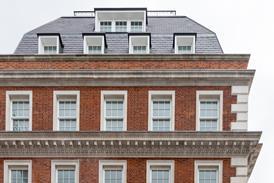The site at Murray Grove, a few blocks north of the City of London in Hackney, contains the Peabody Trust’s much-heralded foray into prefabricated housebuilding. The scheme of 30 flats represents the UK’s first-ever multistorey housing development using volumetric construction, in which flats are prefabricated in 3D modules in the factory before being assembled on site.
Like other housing associations in the South-east, the Peabody Trust has been squeezed by labour shortages, with the result that its housing developments suffer from late completion, high construction costs and shoddy workmanship. Anticipating the Egan principles, Peabody development director Dickon Robinson adopted volumetric construction to deal with two problems in one – halving total construction time to six months or less, and providing workmanship to factory standards. Building costs for the prototype scheme are 20% higher than conventional building costs, but these should be largely recouped in the extra six months’ rental revenue earned by halving construction time.
For the Murray Grove scheme, most of the action takes place 160 miles north in York, where the modules are prefabricated by Yorkon at its 16 ha plant. Yorkon, part of Shepherd Construction Group and sister company to Portakabin, has a well-established track record in modular hotel construction.
But whereas Yorkon usually provides its clients with a turnkey package deal, Robinson insisted on a bespoke architectural design that would lift the scheme above the run-of-the-mill standard for modular construction. Instead of concealing the modules behind a pseudo-domestic skin of brick walls and tiled roofs, Cartwright Pickard Architects has celebrated factory-based construction with lightweight steel balconies and clip-on terracotta tile cladding. And because of its bespoke features, the total contract was awarded to the Japanese firm Kajima, a world leader in prefabricated housing.
“In principle, the technology of modular housing is no different from the hotels we do,” admits Yorkon marketing manager Andy Atkins. The main differences are that the housing units have fully glazed end walls and that they conform to higher standards of sound insulation between units.
Flat panels for walls, floors and ceilings are assembled on one of Yorkon’s two production lines that run the length of a large industrial shed. Rolled hollow-steel sections are welded together and then lined externally with galvanised steel sheeting and internally with a double layer of plasterboard. Insulation and cabling is included in the panels.
Once the panels are assembled into a room-sized box, the modules are moved outside the shed to the open yard for fitting out. The modules are assembled in groups of two or three to make up each flat, and fitting out is done much as it would be done on site. Although the system allows Yorkon to establish a well-trained local labour force, the efficiencies of an automated production line are lost at this stage.
At the same time as the modules were being prefabricated in York, Kajima managed the construction of the foundations in augured piles, with insitu concrete for the ground beams.
“We are taking a management approach rather than a design-and-build approach for this project,” says Kajima project surveyor Dean Slayford. “Quality assurance is everything here. We check everything before it is installed and inspect and sign off everything after it is installed, and this is all formalised on paper.
“Setting out is critical,” he continues. “Everything is plotted off a grid system, which is normal for office buildings but certainly not for flats and housing sites.”
An elaborate procedure was used to lay out the modules’ bases. The concrete ground beams, which could not be cast with a tolerance finer than 6 mm over the whole site, were cast about 20 mm below the projected underside of the modules. Chalk lines were drawn to indicate the bearing points of the modules. At these points, steel bearing plates 5 mm thick and 450 × 250 mm in size were bedded up in non-shrinkable grout to within 2 mm of the final level.
Installing the modules was a remarkably quick process. Two 8 × 3.2 m modules were delivered on each lorry and then craned into position. Steel shims varying from 2 to 5 mm thick were slipped in to pack up the module bases to the precise level.
Once the ground-floor modules were bolted together, the four upper storeys were placed on top using a self-aligning system of projecting bars and slots. The stacked metal boxes were designed as monocoques, so that they supported each other without needing an overall structural frame.
The erection of the first 35 modules at Murray Grove was completed in five days, according to plan. A minor irritant in the system concerned the drainage connections. “Yorkon are used to plastic drain pipes and designed the spigots to be cast flush with the ground beams,” Kajima project manager Ken Mills explains. “The trouble is that the clay drains required in inner London can’t be easily manipulated. It would have been more convenient to cast the drains with a 600 mm upstand, so we could fit a flexible plastic sleeve with a double collar over it.”
Once both blocks of flat modules have been installed, construction will move on to the more bespoke elements of the scheme, which are also prefabricated. These include a five-storey steel lift shaft delivered in one piece and access decks in steel and precast concrete. The only work that has to be done to the flats on site is finishing off the joints, services connections between modules and clipping on the external hanging tiles.
The whole construction project at Murray Grove would make Sir John Egan proud.
Credits
developer Peabody Trust architect Cartwright Pickard Architects structural engineer Whitby Bird & Partners services engineer Engineering Design Partnership quantity surveyor MDA Group main contractor Kajima UK Engineering module production Yorkon





















